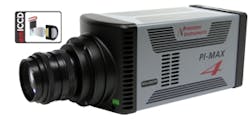Acton, MAhttp://www.emiccd.com
-----
PRESS RELEASE
World's First emICCD Camera Delivers Single-Photon Sensitivity and Subnanosecond Time Resolution
Princeton Instruments is pleased to announce the launch of an innovative new emICCD technology, available exclusively in their renowned PI-MAX®4 camera platform. For the first time ever, one camera combines the advantages of intensifiers (i.e., ultrashort, subnanosecond exposure times) and the benefits of EMCCDs (i.e., linear gain and high quantum efficiency) to provide single-photon sensitivity and quantitative performance for scientific imaging and spectroscopy applications.
For more than three decades, Princeton Instruments ICCD cameras have been the industry standard for time-resolved imaging and spectroscopy applications. The recently introduced PI-MAX4 series of cameras, for example, offers advanced capabilities such as <500 picosecond gating, very high repetition rates, RF modulation, and complete control via a truly revolutionary LightField® software platform with an oscilloscope-like user interface.
"Traditional intensified cameras, the workhorses of ultrashort, time-resolved applications, are limited by nonlinearity due to microchannel plate [MCP] saturation as well as an inability to distinguish single photons. Alternatively, EMCCD cameras, which have become the main tools for low-light applications, lack ultrashort [i.e., psec to µsec] gating capabilities," observes Ravi Guntupalli, Vice President of Sales and Marketing at Princeton Instruments. "However, by combining these two key technologies for the first time, we have created unique emICCDcameras that are free of the aforementioned limitations, allowing researchers in combustion, ultra-low-light chemiluminescence imaging, quantum optics, and time-resolved imaging and spectroscopy to design experiments hitherto not possible."
Explained briefly, in an emICCD camera, either a back- or front-illuminated EMCCD is fiberoptically bonded to a âlatest generationâ intensifier with an S20/S25, GaAs, or GaAsP photocathode for the highest light throughput. By intelligently utilizing both the intensifier (i.e., MCP) gain and the EMCCD gain, the detector provides a larger dynamic range than that of an intensifier alone. This wider linear range of operation is very useful for quantitative measurements in comparing bright and dark scenes within a single image. The same camera can be operated at the highest system gain to detect single photons, overcoming the excess noise limitations of typical âgainâ systems. New emICCD cameras also feature a built-in, fully calibrated, high-precision timing generator with 10 psec time resolution for external synchronization. These high-frame-rate (>30 fps) cameras can be operated remotely via a Gigabit Ethernet (GigE) data interface.
All PI-MAX4 cameras are fully supported by Princeton Instrumentsâ LightField 64-bit data acquisition software platform, which has been designed âfrom the ground upâ for scientific imaging and spectroscopy. LightField provides a visual, interactive timing-setup interface that makes even the most complex synchronization experiments a breeze. The platform remembers each PI-MAX4 userâs hardware and software configurations and tailors its own features accordingly, displaying all relevant tools via an intuitive graphical user interface.
-----
Subscribe now to Laser Focus World magazine; it's free!
